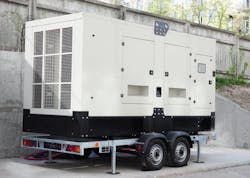Natural Gas and Microgrids: Keep Trucking On for a Long While
Microgrids are a diverse set of generating resources all brought into balance with one another—and ever changing. New technologies in vehicle electrification and bidirectional charging can turn EVs into mobile microgrids.
The sky is the limit, perhaps, but much of the onsite-power capacity, including microgrids, will remain rooted in fossil generator sets and, more and more, natural gas-fired gen-sets, for years to come.
Earlier this week, a new report by Research Nester predicted that the global generator-set market would continue to expand at an average 8% annual growth rate. This would elevate the current $39 billion market to about $82 billion by 2035, according to the forecast’s summary release.
Mordor Intelligence also forecast that the gas generator market would expand 5% annually through the rest of this decade, although some of move could be thwarted by limited gas pipeline access.
The U.S. revolution in natural gas production will strengthen its hand in the future power generation mix, even in the some of the most ambitious carbon reduction scenarios, according to new research released by the National Renewable Energy Laboratory (NREL). Although the NREL mid-case forecast anticipates solar and wind capacity totaling nearly 2,000 GW combined by 2050, natural gas capacity will grow by another 200 GW.
Utility-scale gas-fired generation is already at about 280 GW, according to the federal Energy Information Administration. Methane gas carries its own highly negative environmental impact, but emits only about half the carbon dioxide (CO2) of coal-fired power, which is considered an inefficient resource and dropping precipitously in the power generation portfolio.
“These natural gas generators, along with other resources such as nuclear, hydropower, storage and geothermal plants, provide a source of firm capacity for periods with low wind and solar output,” reads the NREL study. “Firm capacity is especially important in the winter when solar resources a low and load tends to be high.”
Diesel generators have typically dominated the on-site power and fossil portion of microgrids, but natural gas has been catching up for years, partially due to its lower emissions on a greenhouse gas such as CO2. Diesel will be preferred by many customers and system developers because it can be stored on-site, while natural gas is not efficiently stored (unless in liquified form) and must be moved via pipeline.
On-site storage of diesel, however, often is limited to three days’ supply, while a natural gas pipeline can deliver the resource and keep engines and generators going for weeks and months at a time, according to a report from the Gas Technology Institute.
Even so, natural gas is anticipated to maintain an important role in power generation for decades. Development to scale up hydrogen, which does not contain carbon in its chain, is promising to create some net-zero on-site power, such as a data center project announced recently to be located in West Virginia.
Natural gas is viewed as critical to larger-scale microgrids such as combined heat and power projects at universities, industrial plans and even health care facilities.
Some data center firms, seeking firm capacity but also sustainability goals, are moving toward renewable natural gas and other biofuels. Microsoft, for one, is working with Enchanted Rock on using RNG for data centers in California.
The movement to keep natural gas, eventually with carbon capture, as part of the power generation mix is contributing to the idea that there are many paths to net zero in the commercial, industrial and mission critical facility energy transitions.
About the Author
Rod Walton, Microgrid Knowledge Managing Editor
Managing Editor
For Microgrid Knowledge editorial inquiries, please contact Managing Editor Rod Walton at [email protected].
I’ve spent the last 15 years covering the energy industry as a newspaper and trade journalist. I was an energy writer and business editor at the Tulsa World before moving to business-to-business media at PennWell Publishing, which later became Clarion Events, where I covered the electric power industry. I joined Endeavor Business Media in November 2021 to help launch EnergyTech, one of the company’s newest media brands. I joined Microgrid Knowledge in July 2023.
I earned my Bachelors degree in journalism from the University of Oklahoma. My career stops include the Moore American, Bartlesville Examiner-Enterprise, Wagoner Tribune and Tulsa World, all in Oklahoma . I have been married to Laura for the past 33-plus years and we have four children and one adorable granddaughter. We want the energy transition to make their lives better in the future.
Microgrid Knowledge and EnergyTech are focused on the mission critical and large-scale energy users and their sustainability and resiliency goals. These include the commercial and industrial sectors, as well as the military, universities, data centers and microgrids. The C&I sectors together account for close to 30 percent of greenhouse gas emissions in the U.S.
Many large-scale energy users such as Fortune 500 companies, and mission-critical users such as military bases, universities, healthcare facilities, public safety and data centers, shifting their energy priorities to reach net-zero carbon goals within the coming decades. These include plans for renewable energy power purchase agreements, but also on-site resiliency projects such as microgrids, combined heat and power, rooftop solar, energy storage, digitalization and building efficiency upgrades.

